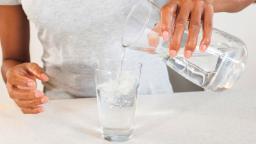Physical Address
304 North Cardinal St.
Dorchester Center, MA 02124
Physical Address
304 North Cardinal St.
Dorchester Center, MA 02124


CNN
–
A new study They found a moderately higher risk of spectrums of autism in children born with pregnant water water with higher levels of lithium, but experts warn that this association does not show a direct connection between the two.
About 1 of 36 children in the United States diagnose a disorder of autism (ASD) each year, according to US disease control and prevention centers.
Scientists still do not know the exact cause of autism, Developmental disorder. Genetics can be a factor, but some also viewed potential environmental reasons.
Cases can be rising, but it is also vague. One study Posted this year in cases in the field of New York Domestic Jersey, the autism’s diagnosis rates tripled among certain age groups between 2000 and 2016. years. Report 2021 They found similar cases increases, but the CDC says the number of cases are most likely associated with More doctors for a condition.
Lithium is an alkaline metal This can be fed in some food and groundwater. It is used in batteries, fats and air conditioners, as well as in the treatment of bipolar disorder and some blood disorders. Its levels in American drinking water is not regulated, According to the American geological research.
A New study, Published on Monday in Jama Pediatrics, he found a small connection between the diagnosis of Lithium and Autism in Denmark, where researchers say the level of lithium in drinking water is similar in American water supply systems.
Researchers checked the database of psychiatric disorders for children born between 2000. and 2013. to find information on 8,842 cases ASD and 43,864 participants who did not have the assasses. Then they measured the concentration of lithiums in 151 public waterworks that served more than half of the Danish population and the copies where pregnant women lived in relation to that.
As the level of lithium-water in the water increased, there was a modest increased risk of ASD diagnosis. Specifically, compared to people at the lowest exposure level, those who had second and third largest exposure during pregnancy had 24% to 26% higher risk of asd diagnosed in children. The group with the highest exposed exposed amounted to 46% higher risk than those at the lowest level of exposure.
The researchers could not speak how much pregnant women drank, but they partially selected Denmark, because residents spend some of the lowest amounts of bottled water in Europe.
Experts say it is important to note that research cannot show that lithium exposure is guided directly to the diagnosis of autism.
The further study is needed, the study of Dr. Beete Ritz studies, professor of neurology in David Geffen to UCLA and professor of epidemiology and environmental health care healthying schooling.
“Any pollution of drinking water that can affect the development of the human brain deserve intense control,” Ritz said in news. She added that research will have to be replicated in other countries to seek a similar relationship.
The implications of the findings are complex as far as public health policy is concerned, according to the editorial board, published together with the study. Library levels in water, in concentrations that study related to potential risk on ASD, also associated with health benefits As below hospitalization rates for psychiatric disorders and suicide.
“If all these associations are valid, the wisdom of Solomon will develop guidelines for lithium in drinking water, which is the maximum protective entire population,” Dr. David C wrote. Bellinger, professor of neurology and psychology at Harvard Medical School. “While the basic biology of ASD is better not understanding, it will be difficult to distinguish the causative causes from false associations.”
Dr. Mak Viznitzer, director of Rainbow Autism at the University Hospitals Rainbow Baby and Children’s Hospital in Cleveland, points to other research on the effects of lithiums on pregnant women who take over mental health disorders. These studies – that look at people exposed to many higher levels than in drinking water – do not show a connection with a temporary antie disorder.
“It is an interesting association, but causality is definitely not proven,” Viznitzer said, who was not involved in a new survey. “We need to see if there is a sustainable and biologically credible mechanism that can make a small amount of lithium in the plumbing, but still pharmacological dosing of lithium in women with bipolar disorder to cause an increased risk of ASD.”
Other studies also proposed connections between ASDs and exposure to the environment of things like pesticides, air pollution and ftalates. But none of them point to any of these factors as a direct cause of a mess.
The connection between environmental exposure and ASD is difficult to prove, Viznitzer said. In addition to research that increased exposure to air pollution raises the risk of a child with ASD, for example, that pollution is whether the pollution is a decisive factor or if it is only the population living in polluted areas.
“There are a lot of guessing about environmental factors, but how much are they really causing them?” Viznitzer said. “We were bombed with various environmental stressors in everyday life. We need to understand how basically they move them safely, and it’s probably not one on our list.”